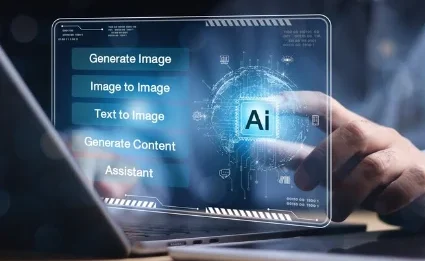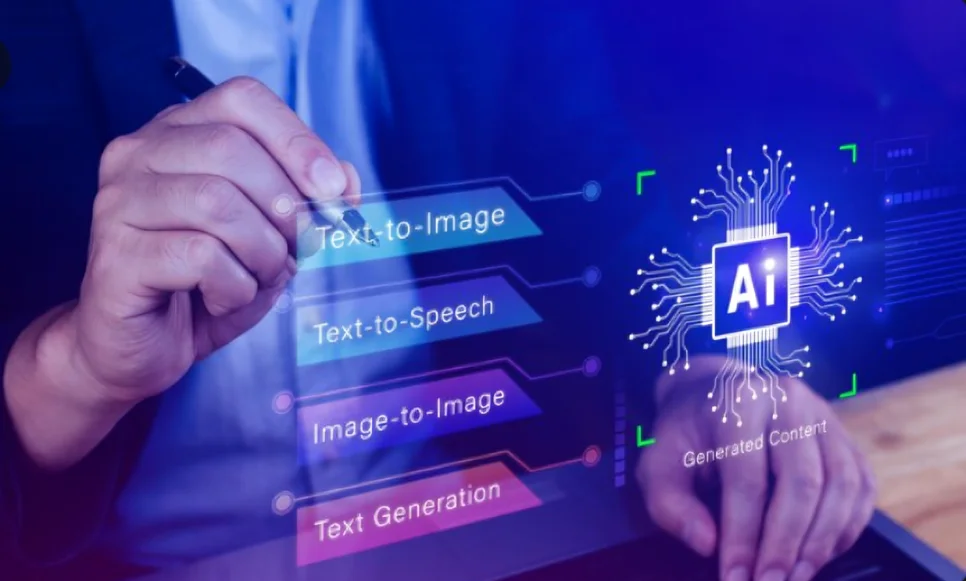If you’ve ever uploaded a photo and wished there was an easy way to get a perfectly written caption or alt text for it, you’re not alone. That’s exactly what AI image description technology delivers: the ability to describe images in natural, human-like language automatically.
In a digital era where visuals dominate everything from social media feeds to e-commerce platforms, AI-powered descriptions are transforming how we handle images. They help improve accessibility, boost SEO rankings, and save huge amounts of time for content creators.
Think of AI image description as having a highly skilled assistant who looks at your images and instantly tells you what’s in them , and does it accurately, consistently, and without fatigue. From detailed product listings to engaging social media captions, this technology has countless applications that can give individuals and businesses a real edge online.
What is AI Image Description?
An AI image description is a text generated by artificial intelligence that explains the content of an image. Unlike a simple label like “dog” or “car,” AI descriptions can be full sentences that provide context, detail, and even style.
For example:
- Basic label: “Dog.”
- AI image description: “A golden retriever puppy running through a grassy park on a sunny afternoon.”
This difference matters because the richer the description, the more useful it is, for both humans and search engines.
The process combines computer vision (so the AI can “see” the image) with natural language processing (so it can “speak” about the image in human-like language).
Why AI Image Description Matters in the Digital Age

The internet is more visual than ever before. Billions of images are uploaded daily, but without descriptions, much of this content is invisible to search engines and inaccessible to people with visual impairments.
Here’s why it matters:
- Accessibility – AI image descriptions make websites usable for people with disabilities, especially those relying on screen readers.
- SEO Benefits – Search engines rely on alt text and descriptions to index images properly. Better descriptions mean better rankings.
- Engagement – Social media posts with clear, descriptive captions often get more likes, comments, and shares.
With visual content dominating online spaces, AI image description has shifted from being a “nice-to-have” feature to a must-have tool for content success.
How AI Image Description Works
While it might seem magical that a machine can “look” at a picture and instantly describe it, there’s a lot of sophisticated technology happening behind the scenes.
The Role of Computer Vision in AI Image Description
Computer vision is the AI field that allows machines to interpret and process visual data from the real world. In the context of AI image description:
- Object Detection – Identifies objects in the image (e.g., “cat,” “tree,” “laptop”).
- Scene Recognition – Determines where the objects are (e.g., “in a living room,” “on a beach”).
- Activity Recognition – Understands actions taking place (e.g., “man playing guitar,” “children building a sandcastle”).
This recognition process often uses convolutional neural networks (CNNs), which are highly effective in analyzing visual patterns.
Natural Language Processing and Context Understanding
Once the visual data is analyzed, the AI uses natural language processing (NLP) to turn that information into human-readable text.
This involves:
- Identifying key details – Objects, settings, colors, activities.
- Determining relationships – Understanding how the objects interact.
- Generating fluent sentences – Making sure the description sounds natural and grammatically correct.
For example:
- Visual data: “Person,” “bicycle,” “road,” “sunset.”
- AI-generated description: “A man riding a bicycle on a quiet road during a vibrant sunset.”
This combination of computer vision and NLP is what makes AI image descriptions sound authentic rather than robotic.
Benefits of AI Image Description
Adopting AI image description technology comes with a variety of practical and strategic advantages, whether you’re a small blogger or a large e-commerce store.
Making Content Accessible for All Users
For people with visual impairments, image descriptions are essential. Screen readers can read AI-generated descriptions aloud, allowing these users to fully understand and enjoy online content.
By using AI to create these descriptions automatically, website owners can meet Web Content Accessibility Guidelines (WCAG) without having to write thousands of captions manually.
This not only makes content more inclusive but also demonstrates corporate responsibility, an increasingly important factor for brand trust.
Improving SEO and Search Visibility
Search engines can’t “see” images; they rely entirely on text-based descriptions to understand them. Well-written AI image descriptions can:
- Increase the chances of appearing in Google Image Search.
- Improve the relevance of your content in search rankings.
- Drive more organic traffic to your site.
For example, an e-commerce store selling sneakers could get more clicks if their product images have AI descriptions like: “Red and white running sneakers with breathable mesh upper and cushioned sole.” This is far more searchable than “Sneakers.jpg.”
Use Cases of AI Image Description

The versatility of AI image description means it’s useful across multiple industries and content types.
Social Media and Marketing Campaigns
Social media thrives on eye-catching visuals, but text captions are just as important for driving engagement. AI descriptions can:
- Suggest captions for posts.
- Generate alt text for accessibility.
- Provide SEO-friendly image descriptions for Pinterest or Instagram.
This is especially useful for brands that post daily content. AI can handle bulk captioning so teams can focus on strategy and creativity.
E-Commerce and Online Retail
For online stores, every product image needs an accurate description. AI makes it easy to:
- Quickly create consistent, detailed descriptions for thousands of items.
- Highlight features and styles that help shoppers make buying decisions.
- Ensure that every listing is SEO-friendly to increase visibility.
This is critical in competitive markets where product listings must stand out both visually and in search results.
Key Features of a Good AI Image Description Tool
Not all AI tools are the same; the best ones stand out because of their accuracy, flexibility, and usability.
Accuracy and Context Sensitivity
A good AI image description tool should go beyond simply naming objects. It should recognize relationships, actions, and context.
Example:
- Weak description: “Two people on a boat.
- Strong description: “Two friends fishing on a small wooden boat in a calm lake at sunrise.”
Multilingual and Customization Options
If your audience spans multiple countries, multilingual descriptions are a must. Some AI tools can instantly translate descriptions into dozens of languages, making global outreach effortless.
Customization features, like choosing tone, length, or style, also help align AI output with your brand’s voice.
Comparing AI Image Description Tools

The market for AI image description tools is growing rapidly, and the options range from simple, free caption generators to enterprise-grade solutions with advanced features. Knowing the differences helps you pick the right tool for your needs.
Free vs Paid Solutions
Free Tools
- Good for individuals or small projects.
- Usually limited to a small number of uploads per day.
- Basic object recognition with simple sentence descriptions.
- May not include multilingual support or customization.
Paid Tools
- Ideal for businesses and professionals.
- Often allow bulk uploads and API integration.
- Offer higher accuracy with context-sensitive descriptions.
- Provide customization features for tone, length, and style.
- Include multilingual support for global audiences.
Example:
- A free tool might describe a photo as: “A man with a laptop.”
- A premium tool might say: “A young businessman typing on a silver laptop while sitting at a wooden desk in a bright office space.”
Feature Comparison Chart
| Feature | Free Tools | Paid Tools |
| Upload Limit | 5–20/day | Unlimited or 1000+/day |
| Accuracy | Basic object detection | High-context understanding |
| Customization | Minimal | Tone, length, style options |
| Multilingual | Rare | Common |
| Batch Upload | No | Yes |
| API Access | No | Yes |
| Cost | Free | Subscription/One-time fee |
This table makes it clear: if you need accuracy, speed, and scale, paid options are worth considering.
AI Image Description for Accessibility and Inclusivity

One of the most powerful uses of AI image description is making digital spaces more accessible to everyone.
Assisting the Visually Impaired
For users with visual impairments, AI descriptions act as a bridge between visual and textual information. Screen readers can narrate these descriptions, making content that would otherwise be inaccessible fully understandable.
For example, a travel website can instantly generate image descriptions for scenic photos, enabling visually impaired users to “experience” the location through words.
Meeting Accessibility Standards and Laws
Many countries have legal requirements for online accessibility. Websites must provide alt text or descriptions for images under regulations like:
- WCAG (Web Content Accessibility Guidelines)
- ADA (Americans with Disabilities Act)
- UK Equality Act
AI can help businesses quickly meet these standards, avoiding legal risks while improving user experience.
Limitations of AI Image Description
While AI image description technology is impressive, it’s not flawless. Understanding its limitations helps you use it more effectively.
Common AI Errors and Misinterpretations
- Misidentifying objects – A blurry photo of a dog might be described as a cat.
- Missing context – AI might say “a group of people” without noting they’re at a wedding or protest.
- Lack of emotional tone – AI descriptions are factual but may lack the warmth or creativity of human writing.
The Need for Human Review
AI works best as an assistant, not a replacement. Always review descriptions before publishing, especially in sensitive industries like healthcare, journalism, or law enforcement.
Human editors can add nuance, correct mistakes, and ensure the description fits your brand’s tone.
The Future of AI Image Description
The technology behind AI image description is evolving fast, and future developments will make it even more powerful.
Integration with AR and VR
As augmented reality (AR) and virtual reality (VR) become mainstream, AI descriptions will expand beyond 2D images to describe immersive 3D environments in real time.
Imagine wearing AR glasses that instantly narrate everything in your surroundings, from street signs to facial expressions, providing a new level of accessibility and information.
Smarter, More Personalized Descriptions
Future AI tools will likely adapt descriptions based on user preferences. For example:
- A travel blogger might get more poetic, story-like descriptions.
- An e-commerce store might get concise, feature-focused product captions.
This personalization will make AI descriptions even more effective for different industries.
Step-by-Step Guide to Creating AI Image Descriptions

If you’re ready to start using AI image description, here’s a simple workflow to follow.
Choosing the Right Tool
When selecting a tool, consider:
- Budget – Free vs paid solutions.
- Scale – How many images do you need to process?
- Accuracy – Context awareness and depth.
- Integration – Whether it works with your CMS or e-commerce platform.
Optimizing Descriptions for SEO
Once you have an AI-generated description:
- Insert relevant keywords naturally.
- Keep it under 125 characters for alt text (SEO-friendly).
- Use descriptive, unique sentences for each image to avoid duplication.
Example:
- AI: “A plate of food.”
- Optimized: “A plate of freshly made spaghetti topped with basil and parmesan.”
Best Practices for AI Image Description
Having access to AI tools is great, but using them strategically will make a big difference in quality and effectiveness.
Balancing Automation and Human Editing
AI can produce accurate and fast results, but the best image descriptions often come from a hybrid approach:
- Let AI generate the first draft – This handles the bulk of the work.
- Review for accuracy – Ensure no misidentified objects or wrong contexts.
- Add personality – Insert brand tone, emotions, or storytelling elements.
For example, AI might write: “A woman holding a cup of coffee.”
You could enhance it to: “A smiling woman enjoying a steaming cup of coffee on a rainy morning.”
Avoiding Keyword Stuffing
While AI image descriptions can help SEO, overloading them with keywords can hurt readability and even get your site penalized by search engines.
Good practice:
- Use keywords naturally.
- Focus on describing the image accurately first.
- Let keywords flow from the description rather than forcing them in.
Example:
- Bad: “Coffee mug coffee lover coffee drink hot coffee ceramic coffee cup.”
- Good: “A ceramic coffee mug filled with hot espresso, resting on a wooden desk beside a notepad.”
AI Image Description for Businesses
Businesses can gain significant advantages by incorporating AI-generated image descriptions into their content strategy.
Boosting Customer Engagement
Clear, engaging image descriptions can:
- Increase social media shares.
- Encourage longer on-page engagement.
- Help customers visualize products better.
For example, a fashion retailer using rich AI descriptions for clothing items might see more customers clicking “add to cart” because the descriptions help them picture how the outfit would look in real life.
Increasing Conversion Rates
In e-commerce, small details matter. Well-written AI image descriptions can highlight features customers care about , fabric type, dimensions, colors, and styles , which can push hesitant buyers to make a purchase.
For service-based businesses, image descriptions can enhance trust by clearly showing work quality, facilities, or events.
Security and Privacy in AI Image Description
Using AI for images brings up important questions about data privacy and security.
How Tools Manage Your Data
Reputable AI image description providers will:
- Delete uploaded images after processing.
- Offer clear privacy policies.
- Avoid selling your data to third parties.
Some may store anonymized data to improve algorithms, but this should always be disclosed to the user.
Protecting Sensitive Images
If your images contain private or sensitive information (medical data, personal photos, legal documents):
- Blur identifying details before upload.
- Use end-to-end encrypted platforms.
- Ensure compliance with relevant laws like GDPR or HIPAA.
How to Select the Best AI Image Description Tool

With so many tools available, choosing the right one can feel overwhelming, but a structured approach can help.
Factors to Consider
- Accuracy – Can it understand context and produce natural sentences?
- Customization – Can you adjust tone and style?
- Speed – How fast does it process large batches?
- Integrations – Does it work with your CMS or e-commerce system?
- Price – Does the value match your budget?
Testing and Comparing Tools
The best way to choose is to test multiple tools on the same set of images. Compare:
- Clarity and accuracy of descriptions.
- How much editing do you need afterward?
- Language and tone flexibility.
This trial-and-error method helps you find the tool that best fits your workflow.
Final Thoughts on AI Image Description
The AI image description is more than a tech trend; it’s a powerful, practical tool reshaping how we manage and share visual content. By combining computer vision with natural language processing, it bridges the gap between images and words, making content more accessible, searchable, and engaging.
For businesses, AI image description is a competitive advantage. It saves time, boosts SEO, improves accessibility, and provides a better user experience. For individuals, it simplifies tasks like caption writing and alt-text creation, freeing up more time for creativity.
However, AI works best when combined with human oversight. Machines excel at speed and consistency, but humans bring nuance, creativity, and emotional depth to descriptions. Together, they create the perfect balance for high-quality image content.
As technology evolves, expect AI image description tools to become even smarter, capable of producing richer, more personalized, and context-aware captions. The future of online visuals is not just about what we see, but how we describe what we see.
FAQs
- What is AI image description used for?
AI image description is used to automatically generate captions or alt text for images, improving accessibility, SEO, and user engagement. - How accurate are AI image descriptions?
Accuracy depends on the tool and image quality. Advanced tools can produce highly accurate, context-aware descriptions, but human review is still recommended. - Can AI image description help with SEO?
Yes. Search engines rely on descriptive text to understand and index images. AI-generated descriptions can improve ranking in both web and image searches. - Is AI image description safe for private images?
It can be, but always check a tool’s privacy policy. Use encrypted platforms for sensitive or personal images. - Will AI replace human writers for image descriptions?
No, AI is best as a helper, producing drafts that humans can refine for tone, style, and emotional impact.










